Not all stakeholders need the same amount of attention. Conducting a thorough stakeholder assessment tells who you need to engage with and to what extent. Learn the ins and outs of stakeholder analysis, along with the best tools and techniques you can use to ensure an accurate stakeholder analysis and the best possible outcome for your project.
- What is a stakeholder?
- What is stakeholder analysis?
- Why is stakeholder analysis important?
- When should you conduct a stakeholder analysis?
- Stakeholder identification techniques
- Common strategies and tools for identifying stakeholders
- Stakeholder analysis example
- Stakeholder analysis tools and templates
- Understanding stakeholder motivations
- Use fit-for-purpose tools to extract valuable insights from your stakeholder analysis
What is a stakeholder?
A stakeholder is any individual, group, or organization that has an interest in, is affected by, or can influence a company’s activities and decisions. Stakeholders can be internal, like employees and shareholders, or external, such as local communities, regulators, and environmental groups. Stakeholder concerns and interests can range from financial returns and employment opportunities to regulatory compliance and environmental protection. Businesses must address the needs of their stakeholders and engage with them to operate effectively and maintain their social license to operate.
What is stakeholder analysis?
Stakeholder analysis is the process used to identify and assess the importance, influence, interests, or impact of various stakeholders in relation to a project or business decision. The primary objective of stakeholder analysis is to ensure that the needs and opinions of stakeholders are considered, allowing for better decision-making and the effective management of potential conflicts or issues.
Steps in stakeholder analysis
Step 1: Identify your stakeholders
- Draw up a comprehensive list of all individuals and groups who may impact – or be impacted by – your project.
- Ensure all affected parties are recognized and duly considered.
Step 2: Understand your stakeholders
- Identify the issues that matter to them, along with their expectations and needs.
Step 3: Group your stakeholders
- Classify stakeholders according to their levels of interest and influence to strategically target your engagements.
- Identify how different groups interact and how those interactions may help or harm your interests.
Step 4: Evaluate your key stakeholders
- Identify stakeholders with the most interest and influence in your project.
- Identify potential risks, issues, or misunderstandings that could disrupt the project, and proactively address concerns to secure social acceptance and improve outcomes.
Why is stakeholder analysis important?
A careful analysis of stakeholders will tell you who supports and opposes your project, how strongly they feel about it, and how much they can affect its outcome. This information will help you determine who you need to engage, when, and to what extent so that you don’t spend time and resources unnecessarily.
Among other things, a thorough stakeholder assessment will help you decide:
- How often you need to engage with each stakeholder or stakeholder group
- Weekly, monthly or quarterly?
- At the start of key project phases?
- On a need-to-know basis?
- Which types of communication and messaging will be most successful for each stakeholder or stakeholder group
- In-person one-on-one meetings or community forums?
- Text message or social media?
- Through emails or phone calls?
- With detailed reports?
Main benefits of stakeholder analysis
1. Understand stakeholder interests and expectations
2. Manage stakeholder risk
3. Gain stakeholder support
4. Make better decisions
5. Optimize resource allocation
Understanding which stakeholders have the most influence or interest in a project can help in prioritizing resources, including time, money, and communication efforts.
6. Build more productive relationships
Regular engagement with stakeholders builds trust and long-term relationships, which can be beneficial for current and future endeavors. These relationships can facilitate collaboration, support, and mutual understanding.
7. Promote transparency
8. Demonstrate moral and ethical practices
Ethically, it’s right to consider the interests of and impacts on those affected by a decision or project. Ignoring stakeholders can lead to negative social, environmental, or economic consequences.
9. Comply with legal and other requirements
In some sectors or regions, engaging with stakeholders might be a legal or regulatory requirement. Failing to engage can lead to legal complications, penalties, or project delays.
10. Improve project outcomes
Projects that consider stakeholder interests are more likely to succeed. This is because they are shaped with a broader perspective and address potential challenges ahead of time.
11. Improve reputation
When should you conduct a stakeholder analysis?
Stakeholder analysis is an ongoing exercise. If possible, you’ll want to perform your first analysis during the early stages of your project, as it will provide insights to help you proactively develop your engagement strategies.
Over the life of a project, stakeholders will come and go, and people’s opinions may change. Each analysis is a snapshot of a certain point in the project timeline. Repeating your analysis on a regular basis will show you how your stakeholders are evolving over time: Who your key stakeholders are, how the needs and expectations of different groups are shifting, and how your relationship with them has changed.
Whether you choose to conduct a new stakeholder analysis every six months or just before each new project stage, be sure to allocate the necessary resources to conduct recurring analyses.
With each new analysis, you should update your stakeholder strategies and messaging accordingly to avoid wasting precious resources on stakeholders and messages that are no longer relevant.
Following a clear, proven methodology can help your team engage in a more strategic, proactive way.
Stakeholder identification techniques
The first step in stakeholder analysis is to identify all of the people involved. Keep in mind some stakeholders will be internal while others will be external.
How to identify stakeholders
When identifying stakeholders, you need to think broadly. The goal is to recognize all entities that can influence or be influenced by the organization’s decisions and actions.
The following techniques and tools are just some of the ways an organization could ensure important stakeholders aren’t overlooked.
Stakeholder mapping and brainstorming sessions
Organize sessions where team members from various departments brainstorm potential stakeholders. This can be visualized using stakeholder maps.
Feedback mechanisms
Create avenues for feedback, such as suggestion boxes or online portals, where both internal and external entities can share their views.
Advisors and consultants
Ongoing monitoring
Identifying Internal stakeholders
- An easy way to begin is by reviewing organizational chart. The organization’s hierarchy can help identify key departments, teams, and individuals.
- Getting feedback from employees through surveys can help understand employees’ perspectives and identify those with a stake in specific projects or decisions.
- Going through job description to understand each role’s duties and responsibilities can be a great way to identify those who might be impacted by or have an impact on certain projects or decisions.
- Questioning managers and supervisors can often provide insights into who within the organization will be most affected by or influential in a particular decision or project.
Identifying external stakeholders
- Researching a particular business sector to conduct a thorough industry analysis can provide insights into key players, such as competitors, suppliers, and industry regulators.
- Reviewing client and customer lists helps to identify those who may have a vested interest in the organization’s activities.
- Asking external entities to conduct surveys can be used to gauge the perspectives of customers, suppliers, partners, and other external stakeholders.
- For projects with potential community impacts, speaking with community leaders or representatives can provide insights into local stakeholder groups.
- Influencers, activists, and the media can be important stakeholders. Public and media relations team can help monitor media coverage and public discussions related to your organization and identify untapped stakeholders.
- Reviewing laws and regulations related to your organization’s operations can help identify regulatory bodies and other official entities as stakeholders.
- Conducting a financial analysis will help you identify crucial stakeholders such as investors, shareholders, and financial institutions with ties to the organization.
- Examining your supply chain to identify vendors, suppliers, distributors, and other key partners. These stakeholders definitely need to be monitored.
- Looking at similar organizations or competitors and their stakeholder engagement practices for insights.
- If your organization is part of an industry association or if there are unions involved, listing professional association and unions can be a good start to identify external stakeholders.
What are the different types of stakeholders?
Stakeholders can be broadly categorized based on various criteria such as their relationship to the organization, their level of influence, or their interest in the organization’s actions.
Internal vs. External stakeholders
Internal stakeholders refer to individuals or groups within an organization (employees, owners, and board of directors are good examples.
External stakeholders are individuals or groups outside of the organization but are affected by its decisions and actions. Depending on its activities and projects, an organization usually has more external stakeholders than internal ones. This can include customers/clients, suppliers and vendors, investors and shareholders, creditors, community, landowners, regulators, partners or collaborators, NGO, associations and community groups.
Primary vs. Secondary Stakeholders
Primary stakeholders are those individuals or businesses directly affected by an organization’s actions, objectives, and policies such as employees, landowners, community around the project, and customers.
Secondary stakeholders refer to people and organizations who are indirectly affected by a project or business activities. Like the media, industry association, competitors, and the general public, for example.
Influential vs. Non-Influential Stakeholders
Influential stakeholders are those who have significant sway or influence over an organization’s decisions and actions. Good examples of influential stakeholders would be: Major shareholders, regulators, or significant clients. They could also be groups that have been defined by law or project requirements as important: Tribal groups and environmental justice communities for example.
Non-influential stakeholders on the other hand are individuals or groups whose interests matter but might not have significant power to affect change directly (also referred to as latent or tertiary stakeholders). These stakeholders can varie widely and range from: individual community members, casual customers, non-active shareholders, indirect suppliers, and minority groups.
Supportive vs. Non-Supportive (or Adversarial) Stakeholders
Supportive stakeholders are those who agree with and support the organization’s goals and objectives. Typically this group is composed of individuals or organizations whose interests align closely with the organization.
On the other hand, non-supportive/adversarial stakeholders may oppose the organization’s actions or policies because their interests are in conflict with the organization’s goals.
Great stakeholder analysis is key when it comes to dealing with adversarial stakeholders.
Common strategies and tools for identifying stakeholders
Identifying stakeholders with a stakeholder identification template
How to use a stakeholder identification template
Choose a template
List all potential stakeholders
Categorize stakeholders
Describe their interest and influence
Interest: Determine the stakeholder’s interest in the project. Are they highly invested in its outcome or only mildly concerned?
Influence: Determine the stakeholder’s power or influence over the project. Can they drive changes, halt progress, or influence decisions?
Note preferred communication methods
Different stakeholders may have different preferred methods (email, SMS, letter, social media, etc) or frequencies of communication. For instance, a major project sponsor might prefer monthly reports, while a local community group might prefer quarterly public meetings.
Detail potential strategies
Monitor and update regularly
Use visuals
Some stakeholder identification templates use visual tools, like matrices. Plotting stakeholders on a matrix based on their influence and interest can help visually prioritize stakeholder management efforts.
Share and review
Create an action plan
Based on your template’s findings, develop a stakeholder engagement plan. This plan will detail how and when you’ll communicate with each stakeholder, address their concerns, and leverage their support.
Stakeholder analysis example
Example of a stakeholder analysis for wind farm energy project
Step1 - Identifying stakeholders
The first step of stakeholder analysis as identified above is to list all known stakeholders of the project. The windfarm created a list of individuals and organization from those groups.
- Local residents
- Environmental & conservation groups
- Local and national government & regulatory authorities
- Potential energy consumers (businesses and residential)
- Company investors and shareholders
- Local fishing and maritime industries
- Nearby tourism businesses
- Renewable energy advocacy groups
Step 2 - Understanding stakeholders
| Group | Main issues and needs |
|---|---|
| Local residents | Concerned about visual and noise pollution, potential impacts on property value, and benefits to the local community like job opportunities. |
| Environmental & conservation groups | Interested in the project’s ecological impact, particularly bird migration and marine life, but also supportive of renewable energy initiatives. |
| Local and national governments | Interested in sustainable energy goals, economic development, job creation, and regulatory compliance. |
| Potential energy consumers | Interested in reliable, cost-effective, and sustainable energy. |
| Company investors and shareholders: | Looking for profitability, sustainable investments, and risk management. |
| Local fishing and maritime industries | Concerned about potential disruptions to fishing routes and marine ecosystems. |
| Nearby tourism businesses | Concerns about potential impacts on the aesthetics of the landscape and tourist attractions. |
| Renewable energy advocacy groups | Supportive of clean energy but keen on ensuring it’s done right without unnecessary environmental impacts. |
Step 3 and 4 - Grouping and evaluating key stakeholders
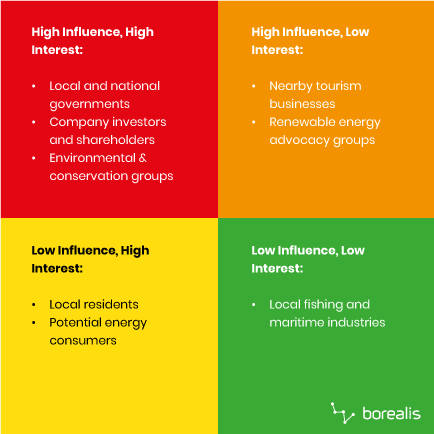
Result : Engage with stakeholders meaningfully
The results of this analysis provided insights to create different engagement plans for different groups.
Local and national governments : Regular meetings to ensure regulatory compliance, discuss mutual benefits, and provide project updates.
Environmental & conservation groups : Share environmental impact assessments, engage in transparent discussions about mitigation strategies, and potentially collaborate on conservation initiatives.
Nearby residents : Host community engagement sessions, establish feedback mechanisms, and ensure transparent communication about the project’s benefits and potential disruptions.
Potential energy consumers : Provide information on energy pricing, reliability, and sustainability advantages.
Nearby tourism businesses : Collaborative initiatives to ensure minimal visual disruption and potentially promote eco-tourism opportunities.
Renewable energy advocacy groups : Keep them informed and potentially collaborate on positive PR campaigns.
Local fishing and maritime industries : Engagement to discuss potential disruptions and ways to mitigate impacts.
Company investors and shareholders : Periodic financial reports, risk assessments, and project progress updates.
Continuous Monitoring
Stakeholder analysis tools and templates
Knowing who your stakeholders are and what motivates them is vital. Stakeholder analysis identifies the people involved as well as their level of involvement, which can help you determine how you should engage with them.
How do I analyze my stakeholders?
There are a number of matrices that can be used for stakeholder analysis. You may wish to consider using a combination of models to gain a more thorough understanding of key stakeholder groups and their potential impact on your project. No matter which model you use, the process is similar:
- Identify project stakeholders
- Assess stakeholders (by interest, influence, knowledge about your project, level of support, etc.)
- Categorize stakeholders into groups that share similar interests and needs.
- Identify effective engagement strategies for each group
Stakeholder matrix & diagrams you can use to assess and classify your stakeholders
- The Power/Interest Grid compares stakeholders based on their authority and involvement in the project. This simple matrix shows a stakeholder’s level of influence on one axis, and how much your organization impacts (or is impacted by) these stakeholders on the other. This helps you focus your time and energy on people who can contribute most to the project’s success or failure.
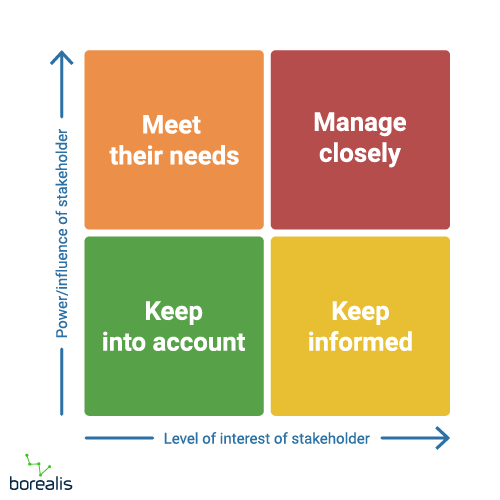
- The Salience Model assigns stakeholders to one of seven classes, which are prioritized based on their levels of power, legitimacy, and urgency. All stakeholders fall into three overlapping circles, as shown in the Venn diagram here. Those who fit into more than one category (indicated by the overlapping sections) require the most attention.
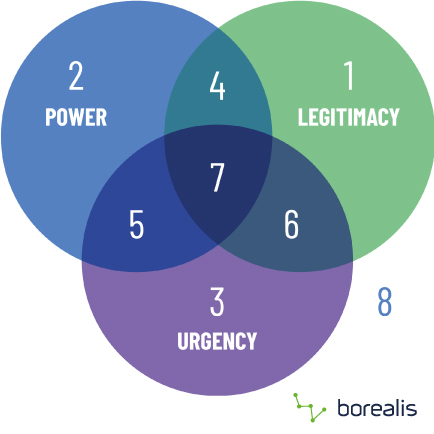
- The Stakeholder Knowledge Base Chart evaluates stakeholders’ levels of awareness and support. This helps teams identify and educate those who are uninformed (or misinformed), and look for ways to manage risks with those who understand the project but still oppose it.
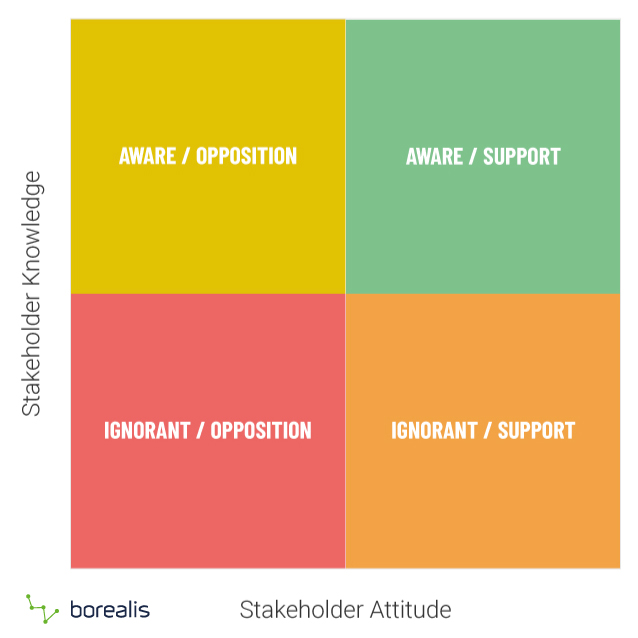
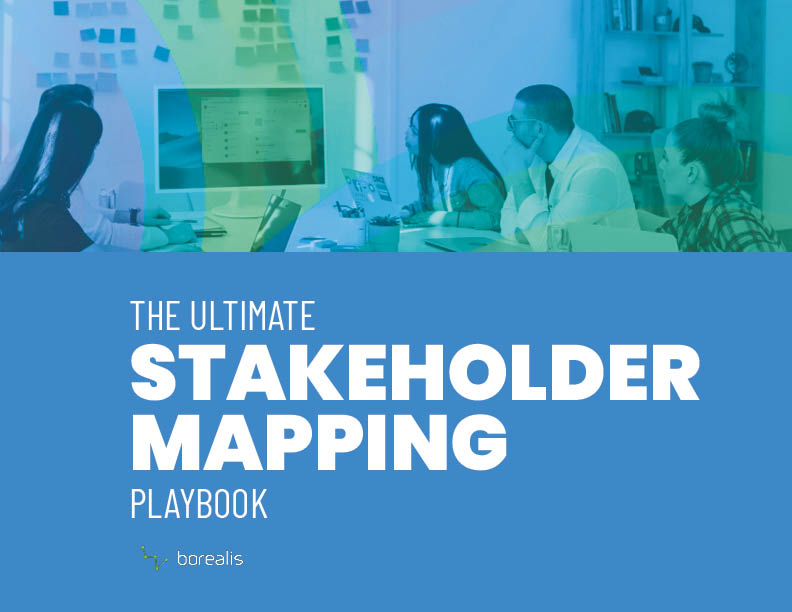
Understanding the stakeholder analysis matrix
Now that you’ve identified your stakeholders and evaluated their levels of involvement, the next step is to prioritize them so that you can create an engagement plan tailored for each group.
Different stakeholder groups require different engagement strategies, in terms of frequency as well as type of interaction. Be sure to consider the quality of your existing relationship with the stakeholders, how they feel about your project, and which issues are most important to them. Ask yourself who needs to know what, and when, and identify strategies that will be effective for each group.
How to prioritize stakeholders
How you prioritize your stakeholders may depend on the nature of your project, available resources, and timeframe. For instance, you may wish to focus the bulk of your engagement activities on stakeholders who are unfamiliar with your project but who stand to benefit from it, so that they can become powerful advocates.
It can also be helpful to establish a tier system to guide your engagements. Here’s an example.
Let’s say you’re part of a Government Relations team that regularly engages with officials about a certain policy issue. As you conduct your stakeholder analysis, you decide to assign your government stakeholders a priority level based on their influence and importance to your cause:
- Level 1 Stakeholders will include highly ranked officials like ministers, members of parliament, governors, senators, and members of congress. You decide to engage with these officials on a monthly basis.
- Level 2 Stakeholders will include people like local elected officials who you need to engage with for the same purpose, but not as often. Your team will engage with these people quarterly.
- Level 3 Stakeholders will include people who aren’t directly involved but who need to be kept informed about your efforts, like directors of community organizations and committee leaders. You decide to update them annually.
Don’t forget that stakeholders’ interests, expectations, and perceptions are dynamic; they can change quickly and unpredictably. Be sure to monitor changes to your stakeholder’s positions over time and adjust your strategies to account for any new developments. This will help you keep your stakeholder analysis – and the strategies that stem from it – up to date.

Understanding stakeholder motivations
Everyone has their own reasons for their personal opinions and actions. Understanding these motivations will help you determine the types of engagements, communications, and even arguments that will be most persuasive.
The goal of stakeholder analysis is to identify and interpret these motivations so they can be adequately addressed.
Here are some of the factors that may be behind stakeholder motivations.
- Financial interests – Will the stakeholder make or lose money because of the project?
- Moral and ethical values – Does the stakeholder believe the project deserves social acceptance?
- Rights – What legal rights, such as occupational health & safety, are affecting the stakeholder’s opinion?
- Religious beliefs – Are religious beliefs involved?
- Political opinion – Could political opinions be triggering support or opposition to the project?
- Business interests – Does the stakeholder expect the project to increase or decrease business revenue?
- Knowledge – How much does the stakeholder know about your project? (Support is often directly proportional to knowledge.)
- Demographics – Factors like age, income, and access to employment opportunities can greatly affect attitudes about your project.
- Environmental stewardship – Is the project’s environmental footprint bringing stakeholders on board, or driving them away?
- Value of ownership – Does the stakeholder stand to gain or lose something of value, such as their farm or quiet neighborhood?
- Communication preferences – Are you communicating with stakeholders in a way that’s meaningful to them? Some stakeholders prefer online communications, while others may value face-to-face meetings.
Use fit-for-purpose tools to extract valuable insights from your stakeholder analysis
Using advanced mapping tools, like those found in Borealis software, will give you even greater insights into the individuals and organizations who influence your project.
Learn more about stakeholder mapping in Borealis: Check out the
stakeholder mapping feature or talk to an expert today!
Stakeholder Analysis FAQ
Questions you can ask include:
- Who are the key stakeholders?
- What are their interests, concerns, and expectations regarding the project?
- How much influence and power do they hold?
- Are they supportive, neutral, or opposed to the project?
- How will they be impacted?
- What are their preferred communication channels?
- What engagement strategies will be most effective for each group?
- How might their positions change over time?
A stakeholder analysis diagram is a visual tool used to categorize and prioritize stakeholders based on factors like influence and interest. Often represented as a matrix, the diagram plots stakeholders in quadrants that classify them as high/low interest and high/low influence. This visualization helps teams decide on tailored engagement strategies for each group and understand their roles and impacts in relation to a project or initiative.
Measuring stakeholder success is important for understanding how well you are managing relationships with stakeholders and meeting their expectations.
Stakeholder success is measured by assessing:
- The alignment of stakeholder expectations with project outcomes
- Their continued engagement and support
- The resolution of their concerns
- The achievement of mutual objectives
Regular feedback sessions, surveys, and the tracking of agreed-upon key performance indicators provide insights into the effectiveness of stakeholder engagement.
To create a stakeholder analysis matrix, plot stakeholders on a two-axis grid: one axis for interest and the other for influence. Assess each stakeholder’s level of interest and influence regarding the project. Place them in the appropriate quadrant: high interest/high influence, high interest/low influence, low interest/high influence, or low interest/low influence.
- This matrix aids in prioritizing stakeholders and determining tailored engagement strategies for each group.
Stakeholders can range from internal teams and customers to regulators, competitors, and the broader community. While there isn’t a single “main technique” for identifying all project stakeholders, several commonly used methods can be combined:
- Brainstorming all potential parties affected by or having interest in a project
- Reviewing project documentation
- Conducting interviews with key personnel and community leaders
- Analyzing organizational structures
- Considering legal or regulatory implications
Remember that stakeholder identification is an iterative process. As a project progresses, new stakeholders might emerge, or the relevance of identified stakeholders might change. Periodically revisit your stakeholder list and adjust as necessary.





